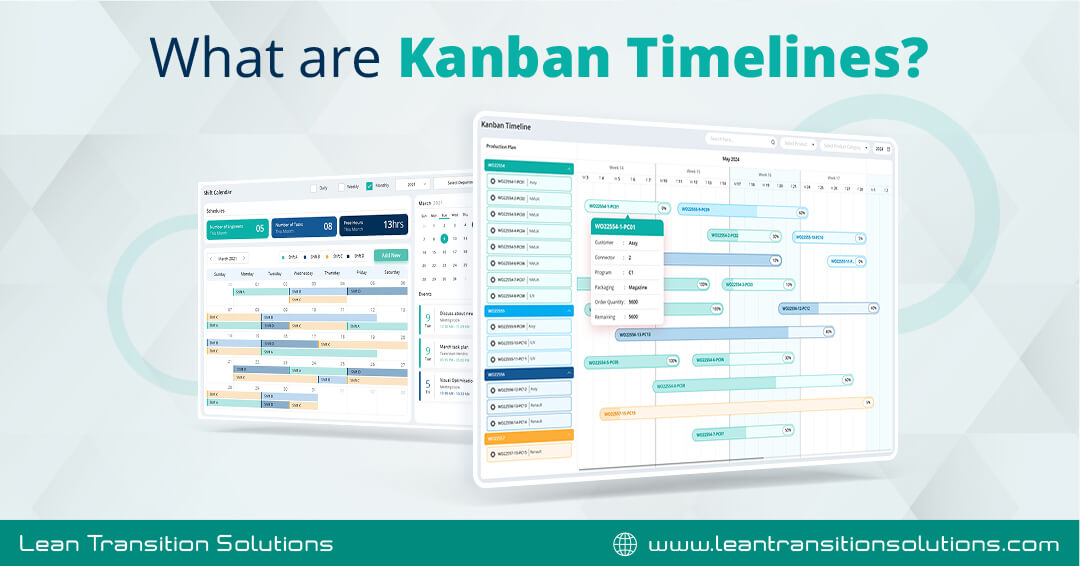What are Kanban Timelines?
May 24, 2024
Project management aims to achieve project goals within set timelines despite encountering constraints. A project manager who manages multiple responsibilities, such as managing multiple people, resources, deadlines, and deliverables, often needs more focus on tasks being handled simultaneously. Project scheduling software tools enable project managers to easily navigate their hectic schedules while ensuring careful project tracking, control, resource planning, and comprehensive organisational workflow management. They also help the team track and manage their tasks within the project cycle and efficiently manage the workflow.
Among the numerous project management tools and software options, Kanban stands out as one of the best due to its robust task management capabilities. With Kanban, project managers can effortlessly create project timelines, streamline task management, and maintain a greater control over their projects, all within a single, user-friendly platform. When you create a project timeline within the Kanban system, it can be called a Kanban Timeline. In other words, a Kanban timeline is a type of project timeline used in project management, such as a Gantt chart, Vertical chart, or Historical timeline. In this blog, Let's understand the Kanban timeline in detail.
What is a Kanban Timeline?
The Kanban board is a visual aid that allows teams to maintain a bird' s-eye view of project schedules. A Kanban Timeline is a visual representation of project schedules, task dependencies and deadlines on a calendar view within the Kanban boards. Kanban methodology is a powerful tool that promotes transparency in projects. Kanban timeline clarifies the workflow and progress of each work item across multiple projects or within a portfolio, making project portfolio management more transparent.
By displaying tasks along the Kanban Timelines, identifying bottlenecks, critical paths, resource allocation, and the estimated project delivery time becomes a simple task, enhancing the overall project efficiency. With features like Kanban swimlanes and customisable Kanban views on the Kanban board, you can effectively organise and prioritise your tasks while embracing portfolio Kanban principles. Kanban Timelines enable you to manage diverse projects seamlessly on a single board, reducing confusion and enhancing collaboration. Project timelines in Kanban or Kanban timelines streamline workflow management and promote transparency, enabling you to track progress and make informed decisions. You can use a combination of each task's start date and due date to visualise a Kanban timeline on the calendar view.
Elements of Kanban Timeline include:
- Work items and its details
- Project Dependencies
- Rows and Kanban Columns
- Calendar
Why Use Kanban Timelines?
The use of Kanban Timelines on digital Kanban boards enhances the project management efficiency by providing clear visibility into schedules, dependencies, and delivery rates. When teams use a Kanban Board for project management it offers several benefits in managing project portfolios which are discussed in the below sections.
Efficient Resource Allocation
By visualising task dependencies and workload distribution, Kanban Timelines enable teams to allocate resources more efficiently.
Teams can identify bottlenecks, balance workloads, and prioritise tasks effectively, leading to optimised resource utilisation and increased productivity.
Enhanced Workflow Management
Kanban Timelines help streamline workflow management by tracking and managing project tasks.
Teams can easily monitor task progress, identify blocked tasks, and take proactive measures to maintain workflow continuity and meet project deadlines.
Visualise and Understand Schedules and Dependencies
Kanban Timelines provide a visual representation of project schedules and task dependencies, allowing teams to grasp the sequence and relationships between tasks easily.
By utilising task due dates and start dates, teams can track the progress of items and identify any bottlenecks or delays in the workflow.
Kanban card timers can be used to analyse task durations and assess deviations from planned schedules, enabling teams to optimise their workflow.
Sense of Schedule for Planned Items
Adding backlog items to the Kanban Timeline helps teams visualise the schedule for upcoming tasks and projects.
This allows teams to prioritise tasks effectively and allocate resources accordingly, ensuring timely completion and delivery of planned items.
Forecast Delivery Rates
Kanban Timelines enable teams to forecast delivery rates by tracking project progress over time.
By analysing historical data and performance metrics, teams can make informed decisions about future delivery rates and project timelines.
Expand Kanban Board Capabilities
Teams can utilise interactive calendar views, or Gantt chart views within the Kanban Timeline on a user-friendly Kanban Board.
These additional views provide comprehensive insights into project schedules and facilitate better planning and coordination among team members.
Improved Decision Making
With real-time insights into project status and performance, stakeholders can make informed decisions regarding resource allocation, prioritisation, and risk mitigation.
Kanban Timelines enable data-driven decision-making, reducing the likelihood of delays, conflicts, and misunderstandings during project execution.
Support for Remote Collaboration
Virtual Kanban boards are a centralised platform for remote teams to collaborate, coordinate, and track project activities in distributed or remote work environments.
Teams can access Kanban Timelines from anywhere, facilitating seamless communication and collaboration across geographical boundaries. They can also use Kanban apps available on any device, further streamlining communication.
How to set Kanban Timelines in your Kanban Board?
Step 1: Setting up the Kanban Board
Choose a suitable digital Kanban tool that supports timeline features and configure the Kanban board layout to accommodate timelines effectively.
Set your Kanban board settings, including Kanban columns, Kanban swimlanes, and Kanban cards, to align with project requirements and Kanban timelines. Choose your preferred view for your Kanban dashboard. Selecting a calendar view can help you better understand your project schedules, task dependencies and deadlines. A Kanban view can help you identify real-time task status, identify the blockers and better manage your workflow without hassle.
Step 2: Define Task Categories and Workflow Stages
Identify and define task categories based on project objectives, such as planning, development, testing, and deployment.
Establish workflow stages within each Kanban column to represent the sequential steps in task completion, ensuring clarity and consistency in the Kanban flow.
Step 3: Populate the Kanban Board with Project Tasks and Timelines
Populate the Kanban board with project tasks using Kanban cards, placing them under relevant workflow stages.
Set start dates, due dates, and estimated completion times for each task to incorporate Kanban timelines and visually represent project schedules in the calendar view.
Step 4: Regularly Update and Monitor Task Progress
Encourage team members to update task status and progress regularly, ensuring real-time visibility into Kanban project timelines and dependencies.
Monitor task movement across workflow stages and promptly address any bottlenecks or delays to maintain project momentum.
Step 5: Utilise Kanban Metrics and Analytics to Optimise Workflow Efficiency
Leverage Kanban metrics and analytics, such as Cycle time, Lead time, and Throughput, to evaluate workflow efficiency and identify improvement areas.
Analyse historical data and performance trends to make data-driven decisions and optimise resource allocation, task prioritisation, and process flow.
Where to Implement Kanban Timelines?
Kanban timelines are essential components in project portfolio management in the Kanban Board, mainly used in manufacturing, construction, HVAC, IT, FMCG, healthcare, pharma, hospitality, logistics, education, energy, electronics, banking, military, and government. Using a single Kanban board with Kanban Timelines is crucial to managing multiple projects effectively. Teams can accurately track schedules, dependencies, and progress across various initiatives by consolidating all projects onto one Kanban board. This approach simplifies workflow management, improving visibility for better task prioritisation and resource allocation. Kanban Timelines empower organisations to achieve greater control and agility in project portfolio management, ensuring the successful execution and delivery of diverse projects.
Who Benefits from Kanban Timelines?
Kanban Timelines offer invaluable benefits to various stakeholders involved in project management processes. Project managers benefit from enhanced visibility and control over project schedules, enabling them to make informed decisions and allocate resources efficiently using Kanban project management software. Team members use Kanban dashboards for clear and transparent task assignments and timelines, facilitating collaboration and coordination. Clients benefit from improved communication and transparency, as they can track project progress and milestones in real-time. Other stakeholders, such as executives, investors, and external partners, benefit from the increased predictability and efficiency achieved through Kanban Timelines, ensuring successful project outcomes and stakeholder satisfaction.
Tips for Maximising the Value of Kanban Timelines
You can maximise the use of Kanban Timelines by considering and following these practical tips and best practices in your Kanban system:
Set realistic timelines and deadlines for tasks to ensure achievable goals and avoid overburdening team members.
Encourage collaboration and communication among team members to foster transparency and shared responsibility.
Adapt Kanban Timelines to suit the specific needs of your project or organisation by customising Kanban board layouts, workflows, and Kanban cards.
Utilise project calendar view and Gantt chart view in Kanban boards to better visualise Kanban Timelines to enhance planning and visualisation.
Continuously review and refine the Kanban board to reflect evolving project requirements, incorporating feedback and learned outcomes to optimise workflow efficiency and effectiveness. Regularly adjust task priorities, and resource allocations as needed to stay aligned with project goals and manage project timelines.
Industrial example of Kanban Timeline utilisation
Implementing a Kanban project management board has proven instrumental in many companies revolutionising their project management approach. For instance, a food processing company visualised their project schedules and dependencies and managed workflow seamlessly using Kanban Timelines, allowing them to handle multiple projects simultaneously. Here's how they achieved this:
Kanban Board Implementation: The company adopted a Kanban board to oversee its production processes. Each task, from ingredient procurement to distribution, was represented as a card on the board.
Visualising Project Schedules: Kanban Timelines allowed teams to visualise project schedules chronologically, based on start and due dates in calendar or Kanban view. This clarity ensured adherence to production schedules without delays.
Managing Workflow: With Kanban, teams tracked task progress through various production stages, streamlining workflow management and enabling effective resource allocation to meet targets.
Switching to Calendar View: During peak production or complex projects, teams utilised the calendar view within Kanban Timelines to better visualise and identify potential scheduling conflicts, facilitating proactive resolution.
Utilising Gantt Chart View: The company turned to the Gantt chart view when closely monitoring project dependencies. This visualisation of task sequences and potential delays ensured tasks were completed correctly to meet deadlines.
Using Kanban Timelines, Calendar views, and Gantt chart views in the Kanban system; the food processing company optimised their project schedules, managed dependencies, and enhanced workflow efficiency. This resulted in improved productivity, timely deliveries, and the consistent delivery of high-quality food products to their customers.
Kanban Timelines are vital tools in project management methodologies, offering unparalleled clarity and efficiency in managing project timelines. By integrating Kanban principles into project management practices, teams can seamlessly visualise project schedules, dependencies, and task management on Kanban boards.
Kanban Timelines provide a comprehensive overview of project progress and schedules, fostering a sense of shared understanding and collaboration among teams. This enables them to prioritise tasks, allocate resources effectively, and maintain workflow continuity. By embracing Kanban Timelines, teams can streamline project management processes, optimise resource utilisation, and foster collaboration among team members. Adopting Kanban Timelines empowers organisations to enhance project delivery, consistently meet deadlines, and achieve desired project outcomes with precision and agility.
